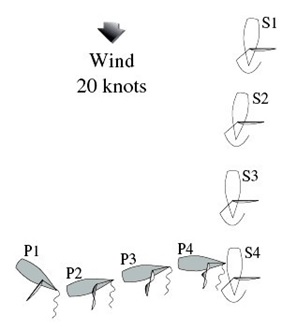



CASE 99
Rule 10 On Opposite Tacks
Rule 14 Avoiding Contact
Rule 44.1 Penalties at the Time of an Incident: Taking a Penalty
Rule 64.2(a) Decisions: Penalties
The fact that a boat required to keep clear is out of control
does not entitle her to exoneration for breaking a rule of Part
2. When a right-of-way boat becomes obliged by rule 14 to
‘avoid contact . . . if reasonably possible’ and the only way
to do so is to crash-gybe, she does not break the rule if she
does not crash-gybe. When a boat’s penalty under rule
44.1(b) is to retire, and she does so (whether because of
choice or necessity), she cannot then be disqualified.

Facts
Farr 30s were racing in difficult conditions. Boat S was running at 10-14
knots. Before boat P reached position 1 she had broached and was out of
control. P struck S amidships resulting in serious damage. Both boats
retired. S protested P.
The protest committee found that S had made minor changes of course when
the boats were well apart; that these were thwarted by the erratic motion of
P, still out of control; and that when it became apparent that P was not going
to keep clear the only action available to S was to crash-gybe, which risked
considerable damage to S.
The protest committee disqualified both boats, P for breaking rule 10 and S
for breaking rule 14, stating that S should have been aware of the difficulties
experienced by P and should have taken more significant action earlier. It
referred its decision to the national authority for confirmation or correction.
Decision
The decisions of the protest committee are reversed. Both boats are to be
scored RET.
Clearly, P broke rules 10 and 14. No rule exonerated her, even though she
was out of control. In breaking rules 10 and 14, P caused serious damage.
Rules 10 and 14 are rules of Part 2, and rule 44.1 permits a boat that breaks
one or more rules of Part 2 to take a penalty. Because P caused serious
damage, the applicable penalty for her was to retire (see rule 44.1(b)). P did
retire (whether because of choice or necessity does not matter) and was,
therefore, exempt from disqualification (see rule 64.2(a)). Her
disqualification is reversed, and she is to be scored RET.
Turning to S, rule 14 makes special provisions in the case of a right-of-way
boat. First, for her to be penalized, there must be contact that caused damage
or injury. This is not in doubt. Second, she was not required to act to avoid
contact until it was clear that P was not keeping clear. It was only at that
time that rule 14 required her to avoid contact if reasonably possible. The
protest committee found that, when it became clear to S that P was not going
to keep clear, the only action available to S was to crash-gybe, which risked
considerable damage to S. That finding was equivalent to a finding that it
was not reasonably possible for S to avoid contact. Therefore, S did not
break rule 14. Her disqualification is reversed, and she too is to be scored
RET.
Finally, the protest committee should note that, in light of the changed
decision, rule 60.3(b) entitles it to call a hearing to consider giving S redress
under rule 62.1(b).
GBR 2001/7






